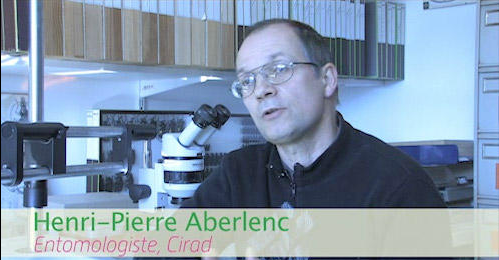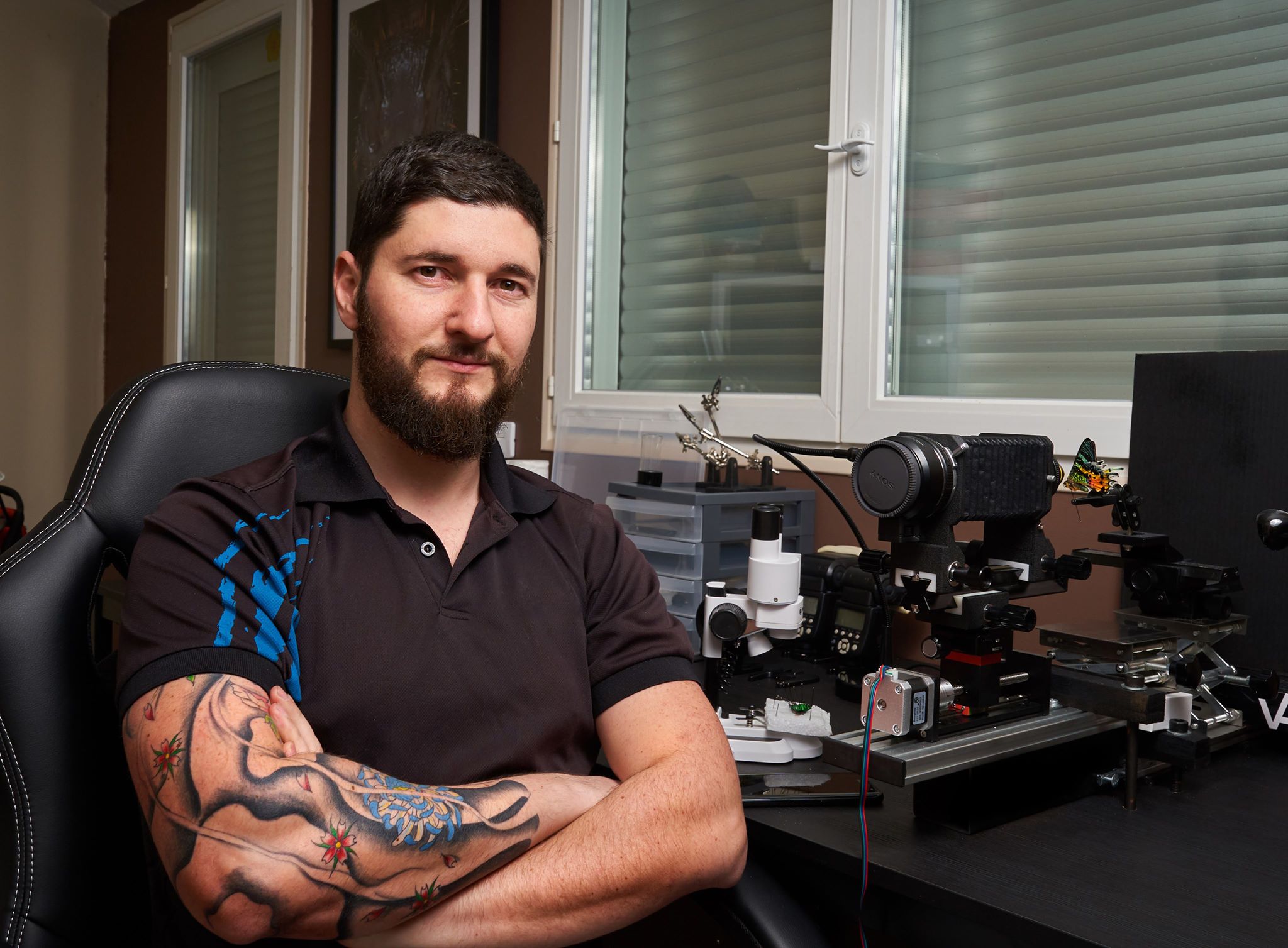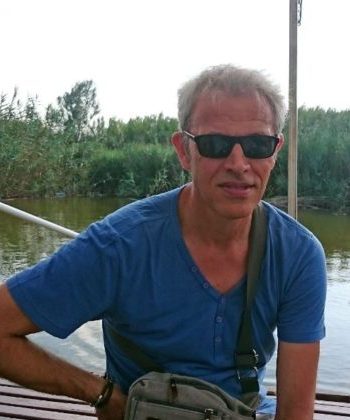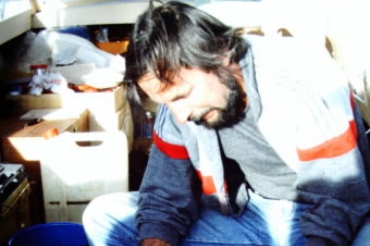Interview de Henri-Pierre ABERLENC
Entomologist at CIRAD
Campus de Baillarguet – Montferrier-sur-lez
Henri-Pierre ABERLENC is an entomologist working at CIRAD, he is a naturalist, taxonomist and specialist in tropical species.
I thank Henri-Pierre ABERLENC for having answered with such enthusiasm to my questions and for offering us this really exciting interview.
-
You are entomological engineer for the CIRAD and within the CBGP, can you present us the organization and the role of these structures ?
Le CIRAD (Centre International de Recherche Agronomique pour le Développement) is a French public agricultural research institute, mainly (but not exclusively) in tropical regions. It has agents in many countries, a Parisian administration and a research centre in Montpellier. The CBGP (Centre de Biologie pour la Gestion des Populations) is a UMR (Unité Mixte de Recherche) based in Montpellier which brings together researchers, engineers and technicians from INRA, IRD, CIRAD and Montpellier SupAgro. We conduct in-depth scientific research on organisms of agronomic interest (invasive species, pests, auxiliaries…) or on biodiversity and phylogeny issues. As an entomologist at CIRAD, we are with my colleagues seconded to CBGP.
-
How long have you been working for CIRAD? What has been your career path?
I have been an entomologist at CIRAD since 1982. My career has been atypical and I do not believe that it would still be possible today, because everything is now calibrated in academic fields, rules, laws and procedures that were not binding or unthinkable thirty years ago. For this kind of career (becoming a modern scientific researcher), you have to be mathematical and have a format and mentality that are foreign to me.
caption id=”attachment_2419″ align=”alignright” width=”330″] Henri-Pierre ABERLENC (Source : CIRAD)[/caption]
Henri-Pierre ABERLENC (Source : CIRAD)[/caption]
Alike Obelix, I fell into the pot when I was little : I could not imagine my life without entomology taking its part, an important part but not exclusive, because I am interested in too many things to be able to confine myself to one ! (This is also the case in entomology: I never stop touching everything, and to kiss too much I never specialized myself). Entomology is a “violent love”, and the enthusiasm of my 11 years comes to the surface very quickly as soon as I come across a new wonder! Too hedonistic and never having been mathematical, I could not make scientific studies, in spite of excellent marks in Biology and Geology and passable in Chemistry.
I was recruited as a technician by the boss (Philippe BRUNEAU DE MIRE, a complete naturalist as we hardly see) of the wildlife laboratory (where we did insect identification) after he tested my entomological knowledge and know-how. Happy times when a lab boss could recruit himself in his team a non graduate after having gauged him on the human level and on his only competences, and not as now according to his diplomas and via a jury and via a rigid procedure supposed to be neutral and fair (but with the dice often piped in secret in reality). Then, I learned a lot on the job and I was able to value my work, climbing the ladder to become an executive and an engineer. Never having been a careerist, it was done almost in spite of myself, under the pressure of my entourage, because the happiness of going to the lab every morning was enough for me…
-
For many people, studying insects is a rather abstract activity, explain us what your job consists of: what are the themes covered? What scientific projects are you currently working on ?
I am an entomologist of the old school : field naturalist who wet his shirt in nature, morphologist and alpha taxonomist in the lab, preparing, dissecting, drawing, photographing, identifying his samples, classifying them in collection and writing his publications in French ! (and under stress in English).
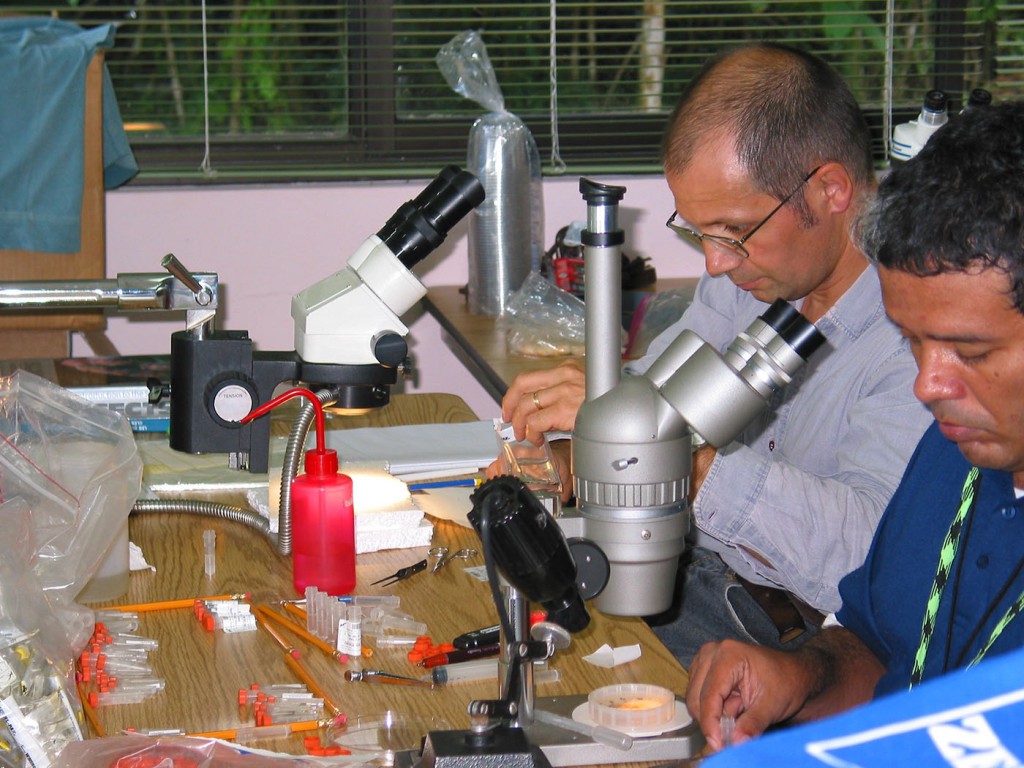
Theme 1 : Expertise – identification
The wildlife lab, which was originally a lab for determining tropical species of agronomic interest, has disappeared, dissolved in the CBGP : with my two entomologist colleagues from the wildlife lab, we continue to make determinations, but it has become very marginal.
Theme 2 : teaching – popularization
We also do some teaching in entomology, in partnership with Montpellier SupAgro. We also train trainees who are either professionals or agronomy students. The time we devote to it is voluntarily reduced, because we have other missions (we are not teachers, nor teacher-researchers).
I published several volumes of the collection “Faune de Madagascar” (IRD Editions – 94 volumes).
I am finishing a vast project that will have been spread over 10 years: the manual “Les insectes du Monde. Biodiversity. Classification. Keys to determining families”: more than 1000 pages, more than 500 plates, 51 co-authors from 14 countries… It is a completely renewed and greatly expanded version of a small textbook published in 1989, originally made for use by our students.
Gathering and coordinating 50 colleagues is not an easy task, and if it is in the end very enriching, what a concern to chase after authors overwhelmed, lacking availability, to constantly relaunch them and ask for their contributions ! And you have to be able to give a unit to a job done with 100 hands, everything to the point again… Writing should be completed by the end of this year, and the manual should be out by the end of 2016. Anyone who’s had to publish a collective book will understand what I’m talking about! And when I think of the famous “Treatise on Zoology”, this monument coordinated by P.P. Grassé, seen through my modest experience, my admiration for the work power of this great man is even greater! We can never pay enough tribute to this great biologist, now unjustly decried and voluntarily forgotten by those who took power in biology.
Theme 3 : systematic search (applied or not)
We publish invasive species records, tropical wildlife studies, species descriptions, genus or family reviews, phylogenies…
-
What are the positive effects of your discoveries on the life of local populations, society in general and from a scientific point of view ?
On local populations: our expertise is generally part of agronomic programmes devoted either to a particular crop (palm, coffee, cocoa, food crops, etc.) or to cropping systems. We are then only a small cog in a much larger whole, and our impact is impossible to assess directly. That said, nothing could be solidly done if we did not know what pest or pest species we are dealing with! Practical utility of systematics, taxonomy and determination !
Sometimes, these are companies that ask us for expertise on pests of stored food, on such invasive species : our usefulness in economic terms is then obvious and immediate. Example: there is a woodpecker in a piece of furniture imported from China, is it a species from here or from China? The species is from China, so the importer is not responsible. Is this species endangering the furniture stock? Etc.
For more than 30 years, individuals (or colleagues not entomologists) panic because a bug invades their house, their garden, come to ask us what they have to do ! Almost always, we reassure them, we de-dramatize… this public service, absolutely informal, unofficial, is also part of our social role…
We bring our modest stone to the world’s entomological literature through our publications, our taxonomic works, and also through our collection, which is a precious heritage testifying to biodiversity.
-
Entomology opens infinite fields of research, such as biology, ecology, systematics, genetics… Which ones do you like ? Why ?
Since 1969, and until today, the beauty of insects never ceases to amaze me. Beauty of the insect living in its environment, beauty of the insect become scientific sample, observed with the bino or SEM (Scanning Electron Microscope). And also beauty of the insect photographed or drawn !
My favourite fields are biodiversity inventory : systematics, mores and biogeography of species. There is an unlimited field of practice here! It is so vast that the horizons are constantly renewed and broadened. And as my sensitivity pushes me to appreciate the beautiful forms and the beautiful colors, the morphological aspect of the systematic could only attract me.
And let’s seize this opportunity to assert with force that claiming to know biodiversity by ignoring systematics and taxonomy is an absolute intellectual and moral imposture.
And also to say that Living is not reduced to DNA sequences, even if it would not exist without it : the whole is not only the simple addition of parts, regrettable mechanistic reductionism inherited from Descartes and whose practical effectiveness masks absolute falsity !
-
Your job consists partly in determining species and describing the biodiversity of agrosystems and ecosystems, if you have one, which family, or species, of insects interests you most? What is so special about it ?
My work over the last 33 years has made me interested in insects from very varied taxonomic groups, which goes with my catch-all side, and therefore I have never specialized in a particular group : I am generalist, with a series of interests. Let’s say I have a weakness for Beetles, but it’s far too large a group to be a specialty!
-
It’s a chance to be able to make a living out of your passion. What is for you the greatest professional satisfaction that your profession offers you ?
It is to be in contact with colleagues from all over France and the world, amateurs and professionals. What human and intellectual enrichment! It is the pleasure to be with a core of close colleagues for more than 30 years: we have worked so much together, we have also shared so many passionate moments and also so much laughter together! Without them, the lab would be sad and empty. It is to constantly discover new things in entomology.
It is also an encounter with tropical countries, with a humanity that is both identical (we are made of the same “human paste”) and incredibly different from ourselves on the cultural level: it avoids the banal blunder of projecting our vision of things onto others. They don’t see them like we do, and so much the better!
I am passionate about biological biodiversity, its knowledge and protection, I am also passionately defender of cultural biodiversity, of the identity of peoples, of linguistic plurality, of the right of all peoples to remain themselves, on their own soil… any biodiversity damaged by globalization.
caption id=”attachment_2426″ align=”alignright” width=”330″]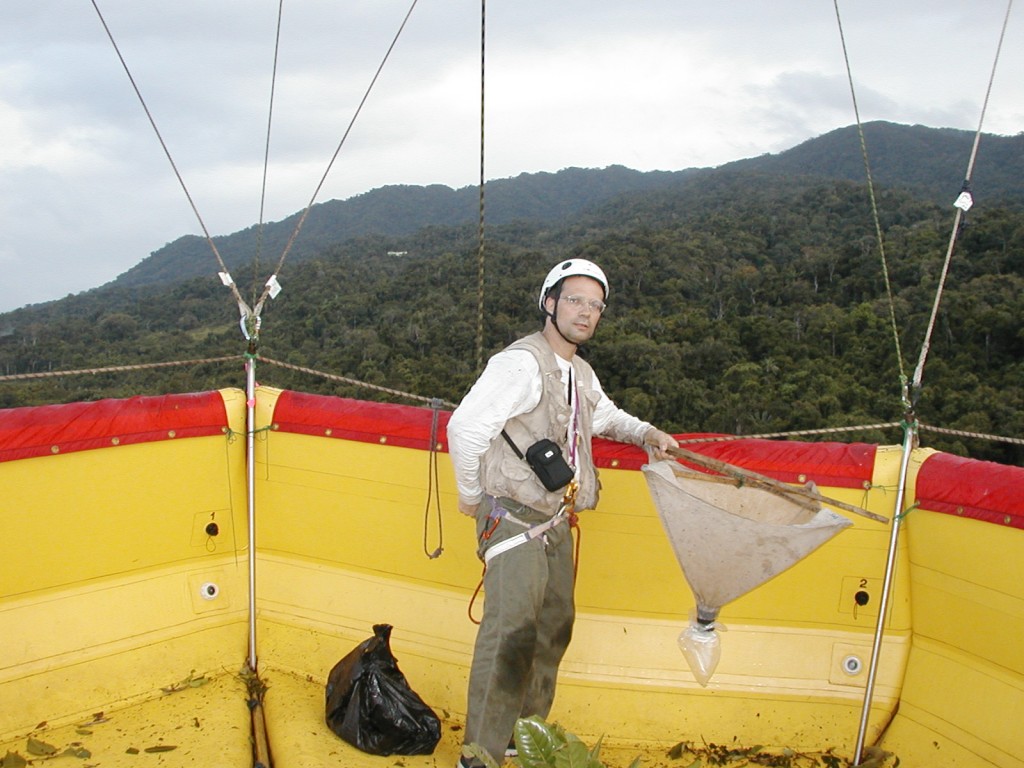 Henri-Pierre ABERLENC on the canopy sledge, on the way for a canopy tree threshing session, in Madagascar in Antongil Bay – 2001 (Source : H-P ABERLENC)[/caption]
Henri-Pierre ABERLENC on the canopy sledge, on the way for a canopy tree threshing session, in Madagascar in Antongil Bay – 2001 (Source : H-P ABERLENC)[/caption]
I am also very happy to work from time to time with Richard RANDRIAMANANTSOA, an excellent Malagasy colleague, on the white grubs (beetle larvae) present in rainfed rice cultivation at altitude in Madagascar: taxonomic and agronomic questions are closely mixed, and the human and entomological aspects of this work will be part of my best professional memories.
I must also mention, from 1989 to 2012, the adventure of the radeau des cimes in which I had the privilege of participating, around Francis HALLE and his team of old friends only unforgettable moments lived with them ! And I also had the privilege of participating in two archaeological expeditions to Vanikoro, a small volcanic island in the Pacific, on the site of the Lapérouse shipwreck in 1788: I contributed to the (fatally incomplete) inventory of the local entomofauna, rich in many endemics…
-
What advice would you give to students who would like to work as an entomologist? What are the qualities to have and what are the professional constraints to take into account ?
Let’s repeat it, my career path, with a great degree of flexibility, initiative and freedom, is no longer possible for a young person in the current research context. She will have been very happy, though overshadowed in recent years by my prospect of being the last of the Mohicans, of feeling cheesy and without successors. I am not sure that there is in France (Muséum, IRD, INRA, CIRAD…) a professional future for young people who would like to do systematics and taxonomy, who know the species in the field and who do morphology. We only recruit molecular scientists who make phylogenies, and there are still few positions.
To do research, you must now have interpersonal skills, a competitive spirit (contemplative and idealistic abstain !
), being able to grasp the changing wind, being a writer of projects most of which will be refused, running after credits, publishing in English (French is only considered as a dialect of old-fashioned – moreover our young science graduates ignore spelling), being obsessed by the H factor and the IF, adhering to the current scientific paradigm (which implies refraining from contesting it).
And don’t think about writing fauns or making books: in terms of career, it’s absolutely counterproductive. It takes time and there is no FI!
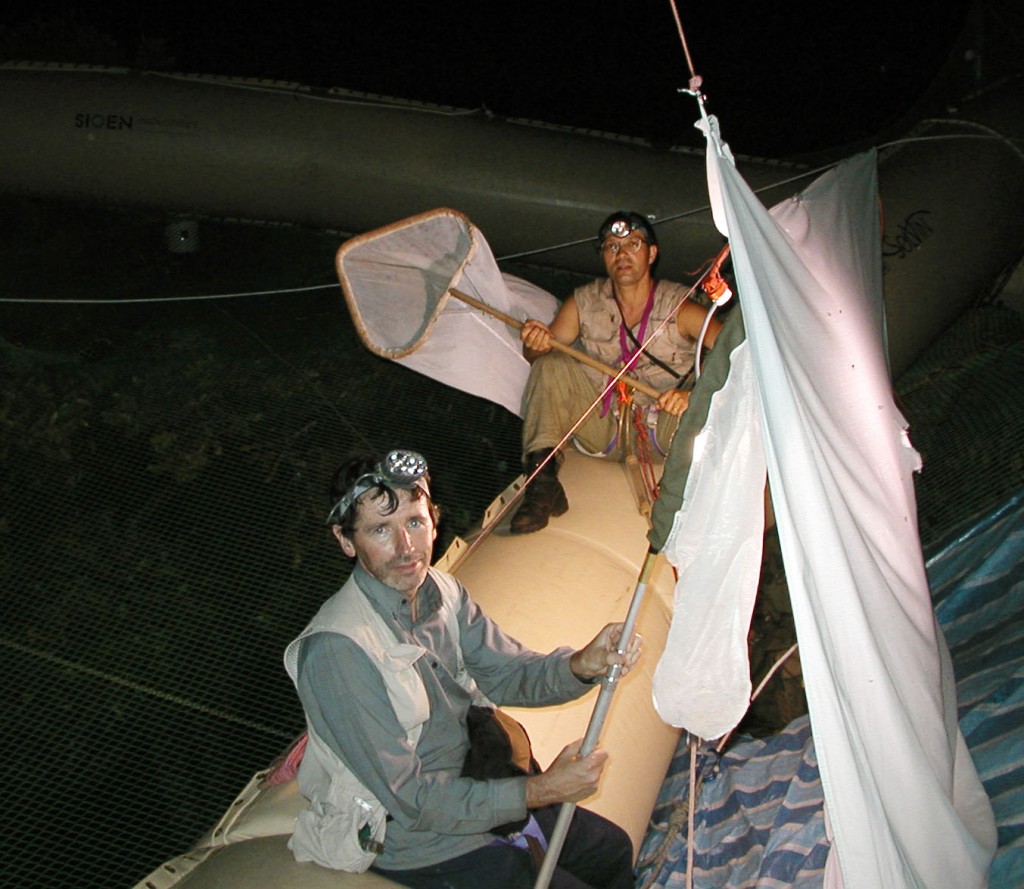
And if one does not have the chance to be recruited, to be a precarious, badly paid after very long studies, an intermittent of science going from one contract to another with periods of unemployment… the intermittents of the spectacle, them, have a much more enviable status ! And don’t think that you will be able to choose the subjects that interest you: you will do what is fashionable and approved by those who will accept your project to finance you. The more time you spend in meetings, in administration, reporting on your activities in reports, being evaluated… you will even have some time left to do research!
So you can spend your doctorate, for example at the Museum or the CBGP, where you will learn to make phylogenies: it will be an intellectual baggage of great interest, but for classical systematics, you will have to be self-taught! And then, to be recruited, there may be a position at CIRAD, or at INRA, or in China, or in France in a design office or in a natural park, or even in a local museum (with how many candidates each time?).
I can only advise a young enthusiastic entomologist (and there are some, thank God) to study science for intellectual baggage, then to do a food profession that leaves enough free time to do entomology as an amateur, freely, while joining one or more associations of Entomologists, starting with the Entomological Society of France.
-
Do you do entomology outside the professional environment? What is your personal involvement ?
Being, as I said, “fallen into the pot when I was little”, I also do entomology privately, in my spare time. Like many colleagues, I have set up a lab room with a library and collection. Living in the south of the Ardèche, I turn to the critters of the region. My subjects of predilections are the edaphic and underground fauna, the inventory of the fauna of the valley of Ibie, etc.
The biggest piece is my participation in the General Inventory of Biodiversity (ATBI) of the ecocomplex of Païolive, within the framework of the”Association Païolive” (law 1901). I coordinate the Arthropods part. There’s a lot of work to do, and I’ve got a lot to do for decades to come! (Colleagues, their contribution to the inventory in their favourite group is welcome! And when they ask me, I give a hand as an entomologist to local associations and nature protection activists (Frapna, Païolive Association, etc.).
-
A la veille de la COP21, never before have issues concerning the preservation of the environment and biodiversity been so crucial, how optimistic are you on this subject? Do you think that biodiversity erosion could be halted in the coming decades ?
No optimism : positive nature protection and anti-pollution measures (which must be supported) are constantly overwhelmed by the general degradation of things (and the little that is done is still contested by the great economic lobbies of cities and countryside, which have an incredible indifference for nature, except for economically exploitable species or species that can be hunted).
 These big international conferences do not lead to anything effective, or at least never to anything equal to what is at stake : smoke and mirrors, which make the public believe that we are doing something ! In any case, everyone talks about biodiversity, which gives the illusion that we are interested in it, but decision-makers do not know what it is, any more than people, or even most scientists: to know what it is, you have to be both a naturalist in the field, observe living beings in their environments and be a taxonomist… and/or really in love with nature. That makes few people in total, or in any case a minority: in spite of the fine speeches (whose tartuferie revolts me), the majority does not care about biodiversity and it is normal, we cannot feel concerned by what we ignore.
These big international conferences do not lead to anything effective, or at least never to anything equal to what is at stake : smoke and mirrors, which make the public believe that we are doing something ! In any case, everyone talks about biodiversity, which gives the illusion that we are interested in it, but decision-makers do not know what it is, any more than people, or even most scientists: to know what it is, you have to be both a naturalist in the field, observe living beings in their environments and be a taxonomist… and/or really in love with nature. That makes few people in total, or in any case a minority: in spite of the fine speeches (whose tartuferie revolts me), the majority does not care about biodiversity and it is normal, we cannot feel concerned by what we ignore.
The erosion of biodiversity will continue, I do not see what could stop the trend ! And I am not talking in the air, but on the basis of my experience as a naturalist in the field for more than 40 years: I see the populations of insect species diminishing, biotopes disappearing, or becoming empty of their fauna, or becoming commonplace… the change that would be necessary would be too radical for it to be possible…
-
Finally, you participated in the inventory of the San Lorenzo forest in Panama, do you have an anecdote to tell us about the discovery of one of these species ?
A hundred entomologists have worked on this project for almost 10 years (not full-time of course
).
In the IBISCA project, more than 6,000 Arthropod species have been recorded on nearly half a hectare, which has made it possible to estimate, by extrapolating this figure by various statistical methods to all 6,000 hectares of forest, that the total number should approach 25,000 species. A huge number compared to those found in temperate forests. Although direct comparison is limited, the San Lorenzo forest supports between 2.1 and 8.4 times more Arthropod species than temperate forests of comparable size. This figure should also be compared with those recorded for the other species present in this forest, which are well known. Thus, for each species of vascular plant, bird and mammal, there are respectively 20, 83 and 312 species of Arthropods : we move to another scale !
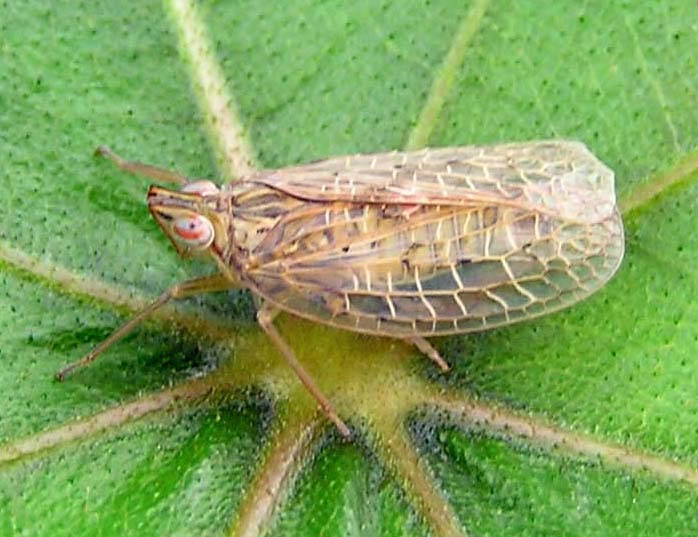
A fulgoromorphic hemipter insect of the family Issidae, Oronoqua ibisca (a nod to the IBISCA project) was discovered and described (see illustration opposite). However, if we found 3 specimens in forest of San Lorenzo, during our investigation, we found 2 other specimens forgotten in the collection of Smithsonian Tropical Research Institute (STRI) in Panama !
And this example is not exceptional : there are many samples of species new to science, forgotten and unknown, because indeterminate, in the collections of the great museums in the world.
Video on this subject to view :
References of certain publications of Henri-Pierre ABERLENC (find all his publications on his site) : </em
- Basset Y., et al. 2012 : How many arthropod species live in a forest tropical? Science – 338:1481-1484
- Randriamanantsoa R. ; Aberlenc H.P. Ratnadass A. & Vercambre B. (2010) : Larvae of Scarabaeoidea (Insecta, Coleoptera) in rainfed rice cultivation in high and mid-altitude regions of central Madagascar. Scarabaeoidea larva (Insecta, Coleoptera) in rainfed rice fields in medium and high altitude areas of central Madagascar. Zoosystema, 32(1) : 19-72
- Gnezdilov V.M. ; Monfils J. ; Aberlenc H.P. & Basset Y. (2010) : Revision of the neotropical genre Oronoqua Fennah, 1947 (Insecta, Hemiptera, Issidae, Issinae). Review of the Neotropical genus Oronoqua Fennah, 1947 (Insecta, Hemiptera, Issidae, Issinae). Zoosystema, 32(2) : 247-257
- Aberlenc H.P & Hamlaoui S. (2011) : Xylomedes coronata (Marseul, 1883), un xylophage polyphage (Coleoptera, Bostrichidae). Bulletin de la Société Entomologique de France, 116(1) : 29-33
Interviews
In the same section, you can discover the interviews of
- David GIRON (entomologist-researcher CNRS – IRBI-Université de Tours)
- Nicolas MOULIN (independent entomologist)
- Patrice BOUCHARD (entomologist researcher – University of Ottawa)
- Marius BREDON (entomologist – graduate of the Master 2 of Tours)
- Bruno MERIGUET (Entomologist – Office Pour les Insectes et leur Environnement – OPIE)
- Adrian Hoskins (Internationally renowned Entomologist – Rhopaloceran Butterfly Specialist)
- Christophe Avon (Entomologist at LEFHE, Director of MAHN-86 and Founder of World Archives of Science – WAS)
- Pierre-Olivier Maquart (Entomologist specializing in African Cerambycidae and Amblypyges – Doctoral student at the University of Sterling)
- Yves Carton (Director of Research emeritus at CNRS – Author of”History of entomology – Relations between French and American biologists – 1830-1940
“)
- Gérard Duvallet (Professor emeritus at the Université Paul-Valéry Montpellier 3, researcher at the Centre d’Ecologie Fonctionnelle et Evolutive (CEFE)
- Pierre Kerner (Lecturer in Evolutionary Development Genetics at the University of Paris Diderot)

